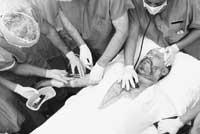Repairing damage from infarction

Myocytes (muscle cells) are thought to regenerate after a heart attack. However, so far no clear evidence has been found to confirm this. Recently, scientists at the New York School of Medicine have found the strongest evidence of all time. The part of the tissue most affected by the infarction and its surroundings has been studied and has been observed to be very large in both levels of mitosis.
One of them is the Ki67 protein. This protein is present in all phases of the cell life cycle, indicating that the cell is dividing and replicating. On the other hand, images of mitosis have been obtained. Another clear signal is the myotic index, which measures the degree of fragmentation of myocytes. Compared to normal hearts, it is observed that in the most affected textile part the number of myocytes is 70 times greater and 24 times greater around it.
The next step is to find the source of the replicating myocytes. Where do these cells come from? They may be cells that retain the ability to fragment after they have suffered the damage, or cells from heart stem cells.
Scientists believe it can be the latter. Therefore, the main objective is to demonstrate the presence of stem cells in the tissues of the heart. Subsequently, these cells intend to move damaged tissue and repair damaged muscle and reduce infarction.





